Shared Features in Art and Architecture From Ptolemaic Period
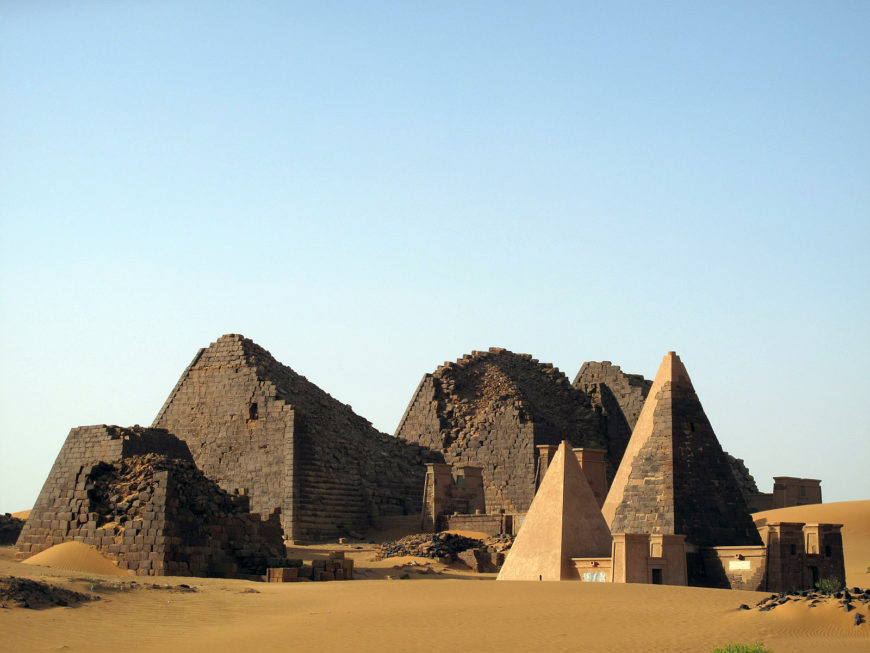
View of the Northward Cemetery at Meroe (Sudan) showing several of the steep-sided pyramid tombs with their pylon-fronted chapels. Xl-one such royal tombs, belonging to both kings and queens, were constructed here betwixt around 300 B.C.E. and 350 C.E. (photo: UNESCO)
Summary
Subsequently the cultural pinnacle and military might of the New Kingdom, the fractured 3rd Intermediate Period led to a loss of control over areas that had been Egyptian territories. Since power vacuums never last, in that location was an immediate rise in the Kushite culture to the south, which reestablished erstwhile cultural centers forth major trade routes and utilized the Egyptian temple structures in Nubia to help legitimize their rule as kings of Egypt. Fifty-fifty though Egypt was largely unified for nearly of Dynasties 25, 26 and 28–30, the era referred to as the Late Catamenia (c. 713–332 B.C.E.) was volatile and endured successive invasions and occupations by the Assyrians and the Persians.
Eventually, Egypt was conquered past Alexander the Great of Macedon in 332 B.C.Due east. Alexander built his new capital letter at Alexandria on the Mediterranean Sea. The subsequent Ptolemaic Period saw a huge increase in settlers of Greek and Mediterranean origins, particularly in the delta. Hellenistic influence was particularly strong at courtroom and in aristocracy circles, with Greek versions of local gods (like Serapis, who was derived from Osiris) holding sway. For the bulk of the country, nonetheless, Egyptian traditions and art were largely unaffected. The Ptolemies presented themselves equally pharaohs and were shown performing traditional cult rituals in the many massive temples synthetic during this period.
When the Ptolemaic ruler Cleopatra VII was defeated by Octavian in xxx B.C.East., Arab republic of egypt became a Roman province. Roman emperors continued to build Egyptian-style temples, with themselves depicted on the walls performing the aforementioned rituals every bit the kings that came before them . Egyptian-style temple constructions undertaken by Rome stopped during the second century C.Eastward., as Rome's own political instability rippled through the empire. Egyptian temples were ordered closed by the Byzantine emperor and the last known hieroglyphic inscription (at Philae) was carved in 394 C.Due east.
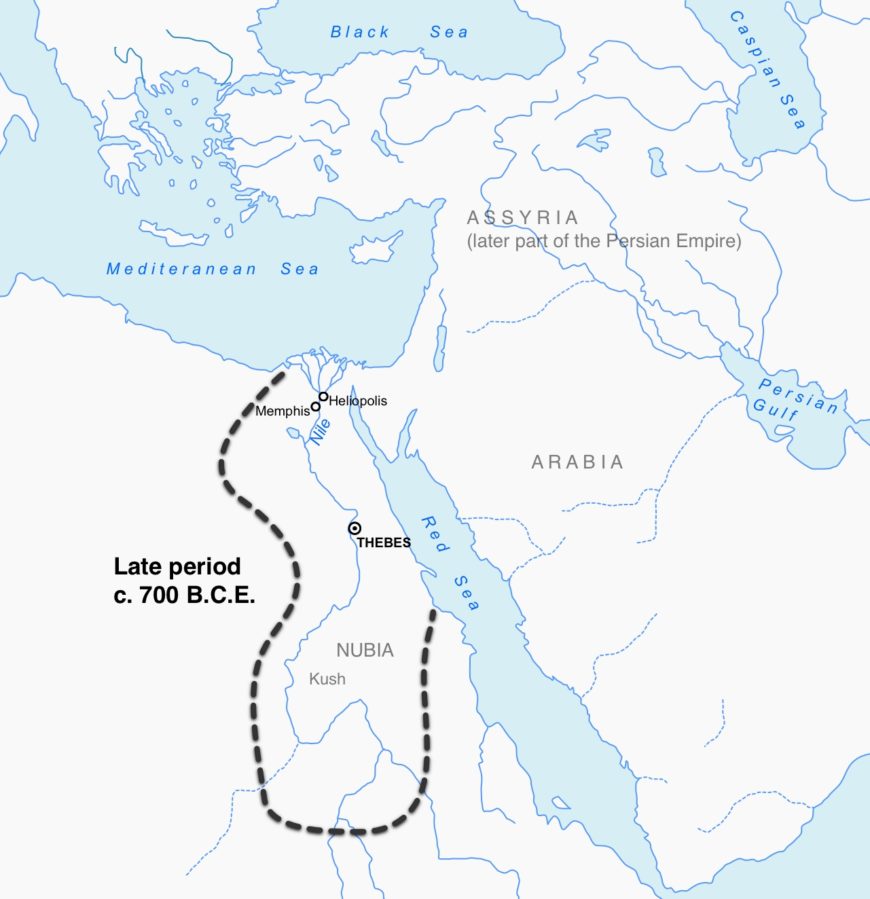
Late menstruation, c. 700 B.C.E.
Tardily Period (c. 713–332 B.C.E.)
The kings of Egypt of the Twenty-fifth Dynasty came from Kush, a civilization that had combined Nubian and Egyptian elements to create something unique. The chief religious site in Kush, the mount of Gebel Barkal, sported temples of Amun-Ra and Hathor and royal inscriptions, such equally on the victory stela of King Piye, are packed with references to Egyptian deities. While they established command as far north as Memphis, they focused more of their attending in the south. At Karnak, the powerful priestess known as the God's Wife of Amun rose fifty-fifty further in eminence; these figures served as imperial surrogates in Thebes for kings who ruled from another location. This function was often filled by princesses of Dynasties 25 and 26.
In the seventh century B.C.E., the Assyrians invaded Arab republic of egypt downward to Thebes and pushed the Nubian kings back to Kush. The Assyrians looted sacred sites, including the temples at Heliopolis and Karnak, stealing massive amounts of treasure. Still, given the armed services needs of their empire elsewhere, they did not have the manpower to leave a big force in Egypt. Instead, they appointed Egyptian governors to collect their tribute. As soon every bit the Assyrians were otherwise occupied, a family from Sais in the delta region took over and ruled an independent Egypt every bit the 20-6th Dynasty.
The Xx-sixth Dynasty kings established themselves down to the southern edge at Elephantine and north into Palestine. They increased their contacts with other Mediterranean powers, including treaties with Lydia, connections at Delphi, and actions on Cyprus. A pregnant Greek trading colony was founded at Naukratis and garrisons of Greek mercenaries helped protect the temples at Memphis.
The next few centuries saw an invasion and period of rule by the Persians, a subsequent brief period of Egyptian rule, followed by a second, more than destructive, Persian invasion. In 332 B.C.E., the Persians were pushed out by Alexander the Peachy of Macedon. He was crowned king in the temple of Ptah at Memphis, alleged himself a living god, and founded the urban center of Alexandria on the coast of the Mediterranean. After his death, Alexander'due south generals divided his empire, with Egypt coming nether the control of the Greek full general, Ptolemy. This family would dominion Arab republic of egypt for the next 300 years.
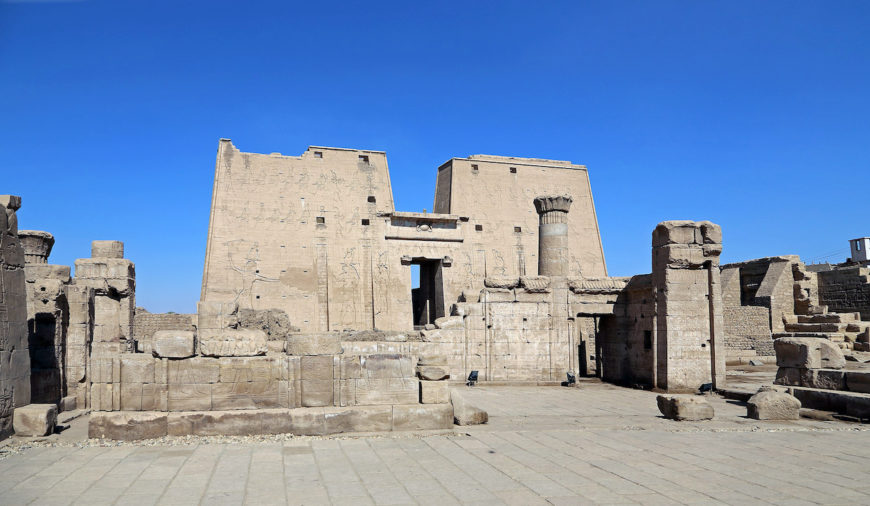
Temple of Edfu, 237–57 BCE, Ptolemaic Period, sandstone, Edfu, Egypt (photo: Marc Ryckaert, CC By-SA 4.0)
Ptolemaic (c. 332–30 B.C.E.) and Roman (c. 30 B.C.Eastward.–395 C.Due east.)
During the Ptolemaic period, the country was ruled from the newly-established metropolis of Alexandria. The construction of the government and administrative organisation was aligned in accordance with Greek practices. Most all important government posts were given to Greek settlers rather than native Egyptians. Although the Ptolemaic era was incomparably multi-cultural and multilingual , with meaning Greek influence evident in many arenas, the ruling family readily identified themselves with Egyptian deities and encouraged the populace to view them as such. Many were crowned in the temple of Ptah at Memphis and they supported ancient religious cults. They likewise undertook a massive temple rebuilding programme to help legitimize their rule. These temples were traditional Egyptian in style, both architecturally and in their decoration, although Greek flourishes are ofttimes discernible in the carving and in that location was a massive increase in the number of hieroglyphic signs used. Ptolemaic rulers had themselves depicted in relief performing the same duties before the divine as their native predecessors had been doing for millennia.
Ptolemaic kings were prolific builders and they synthetic huge temples at Edfu, Esna, Dedera, Kom Ombo, and Philae, amongst others. Beyond the religious realm, Male monarch Ptolemy Ii founded the famous Library of Alexandria, which at its height contained around 700,000 scrolls. This king also completed the dazzling Pharos lighthouse; 1 of the 7 Wonders of the ancient globe.
In 196 B.C.E. King Ptolemy Five Epipanes issued a decree to establish his divine cult. This was carved onto a slab of granodiorite and was probably originally erected in a temple. Three versions of the same decree were engraved on the slab; ii being in ancient Egyptian and ane in Greek. Much afterward, the slab was removed and used as edifice cloth in a fort virtually Rosetta in the delta, where it was discovered by Napoleon'southward expedition in 1799. Being a bilingual certificate with well-known Greek as ane of the languages, the discovery of the Rosetta stone immediately began the race to translate the aboriginal Egyptian language.
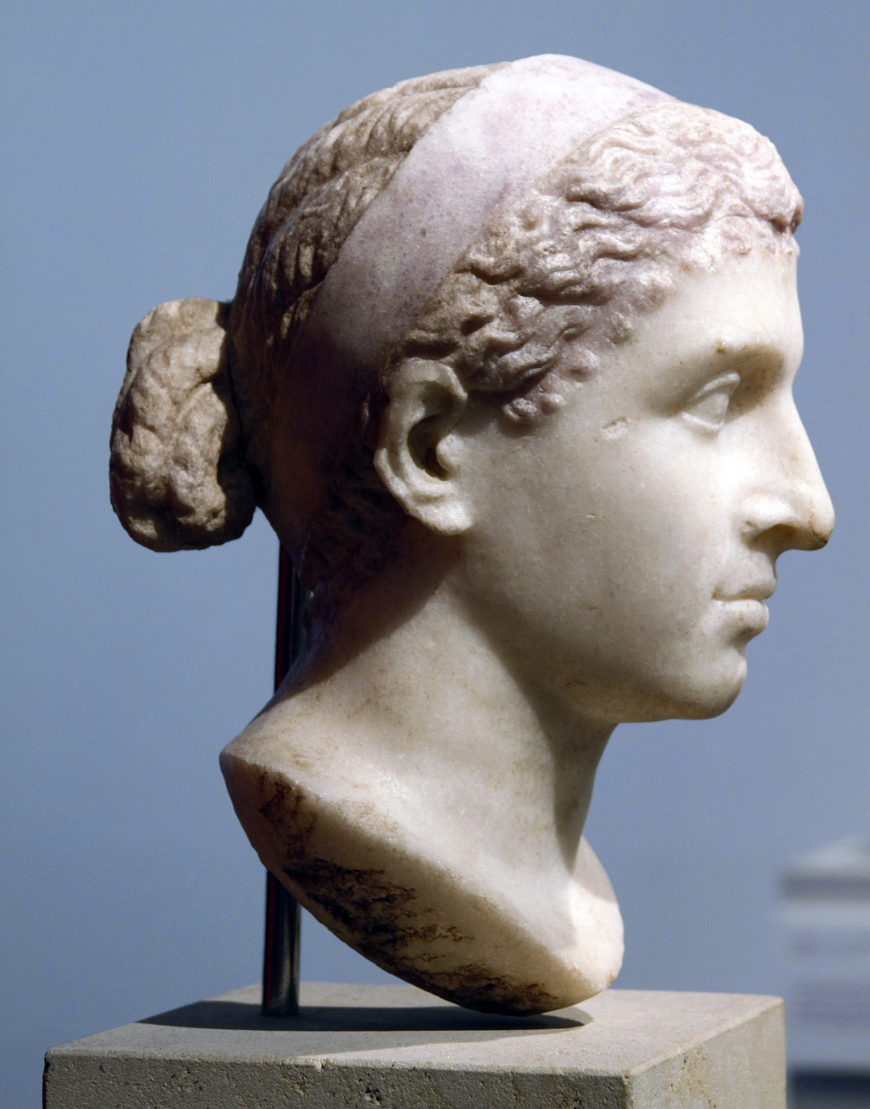
Bosom of Cleopatra VII Thea Philopator, c. 40–xxx B.C.E., marble (Altes Museum, Berlin; photo: José Luiz Bernardes Ribeiro, CC Past-SA iv.0)
The last of the Ptolemaic rulers was Cleopatra VII, who allied herself beginning with Julius Caesar and then with Mark Anthony in an attempt to keep Egypt from being absorbed into the Roman Empire. In the end, she was unsuccessful and in thirty B.C.E. Egypt succumbed to the forces of Octavian, who subsequently became the offset Roman emperor, Augustus. This was the end of Egypt'south independence and information technology became a Roman province.
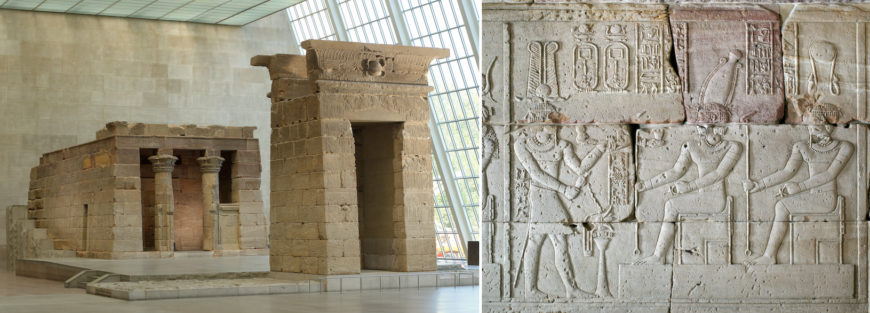
Left: The Temple of Dendur, completed by 10 B.C.E., Roman Catamenia; right: item: vignette on the interior s wall of the porch showing Augustus (left) burning incense in front of the deified figures of Pedesi and Pihor. Both: Egypt, Nubia, Dendur, West bank of the Nile River, 50 miles Southward of Aswan, Aeolian sandstone, Temple proper: H. 6.40 m (21 ft.); W. 6.forty m (21 ft.); 50. 12.fifty m (41 ft.) (The Metropolitan Museum of Art)
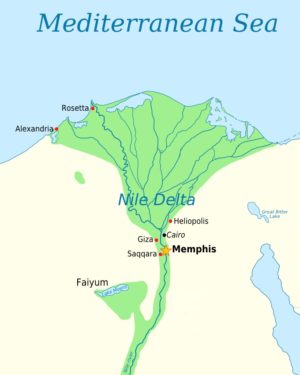
Map of Lower Egypt (adapted from Jeff Dahl, CC BY-SA 3.0)
During the Roman period, Egypt was treated as a bread-basket and source of rich resources. Grain, papyrus, hard stones, statues, obelisks, and treasure of all kinds were removed to Rome and other locations in the empire.
Alexandria was a nexus of Greek civilization and a major hub for trade routes into the desert and to the East. Several Roman emperors, including Augustus, Trajan, and Hadrian, constructed cult temples in Arab republic of egypt and had themselves depicted in the same poses and ritual actions as the kings who ruled before them to help establish their legitimacy. There was a clear involvement in the ancient wisdom of this mysterious and enigmatic land—Arab republic of egypt was renowned throughout the empire as the realm of priest-magicians.
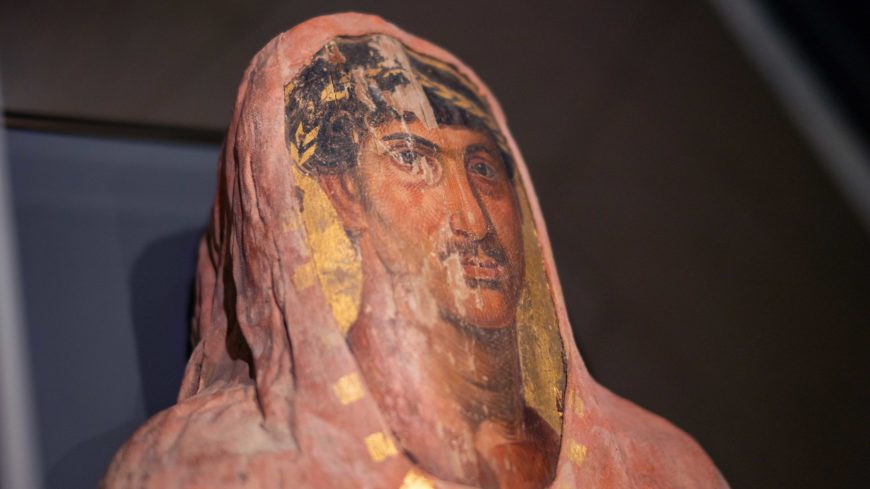
Mummy of Herakleides, 120–140 C.East., Romano-Egyptian, human and bird remains, linen, pigment, beeswax, and woods, created in Egypt (The Getty Villa; photo: Steven Zucker, CC Past-NC-SA ii.0)
Forth the Nile, funerary beliefs remained largely unchanged though more focus was placed on the external embellishment of the torso. Modern styles were added to the painted coffins and images that represented the deceased, with Greco-Roman hairstyles, jewelry, and clothes actualization. Sensitive and haunting portraits of the dead, painted on wooden panels using encaustic (a luminescent wax-based paint that can be built upwards in many layers that creates a dazzling sense of depth) began to be inserted into the bandages over the face of the often elaborately wrapped body. Startling in their realism, they stand for the culmination of the ancient Egyptian desire to ensure that the body was preserved and immediately identifiable.
The classic Egyptian language and hieroglyphs were only used for temple and ritual contexts by this point, however, Coptic emerged as a new written grade of the Egyptian language and proliferated.
As political challenges arose during the second century C.E., less attention was directed at the provinces. Economic changes included an increment in the prominence of urban centers. In 392 C.East. Egyptian temples were ordered closed past the Christian emperor of Byzantium and the last known hieroglyphic inscription (at Philae) was carved in 394 C.E.
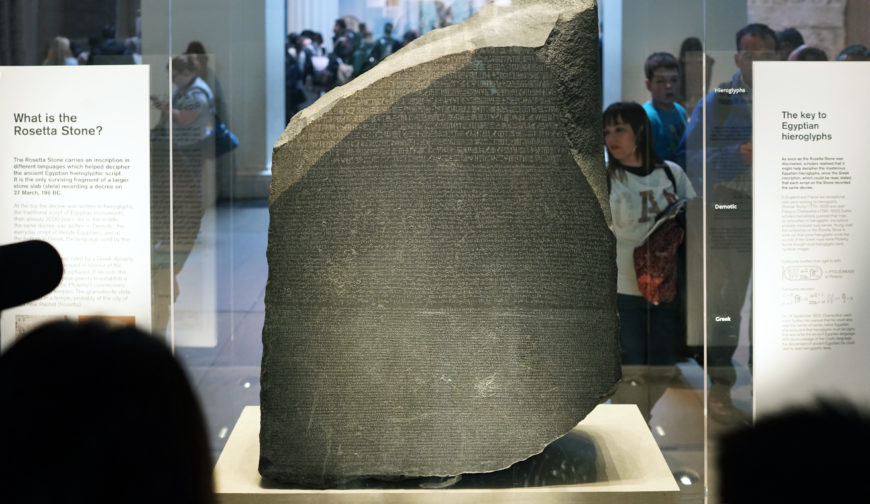
The Rosetta Stone, 196 B.C.E., Ptolemaic Period, 112.3 10 75.7 x 28.four cm, Egypt © Trustees of the British Museum. Office of grey and pink granodiorite stela bearing priestly decree apropos Ptolemy Five in 3 blocks of text: Hieroglyphic (xiv lines), Demotic (32 lines) and Greek (53 lines).
In the fourth century C.East. pharaonic civilization slowly came to an finish as Christianity became the ascendant religion in the Empire. Christianity arrived in Egypt early on in the first century C.E., anchored in the flourishing Jewish community in Alexandria. Said to have been martyred in Alexandria in 66 C.Due east., Saint Mark was referred to as the first bishop of the city, which became a leading intellectual center of the Christian Church. Because information technology was protected by Nubian tribes who honored the goddess Isis, the final operating cult temple in Egypt was that of Isis at Philae on Egypt's southern edge. It airtight in the 6th century C.E. From this point on, no one was left who could read the ancient texts and knowledge of the gods, their myths, and the written history of Egypt itself slipped into shadow until hieroglyphs were deciphered again in the 1800s using what is now known as the Rosetta Stone.
Despite the fact that pharaonic Egypt came to an finish in the late regal Roman menstruum, Arab republic of egypt's influence continues. For instance, Egyptian monuments, such as obelisks, sphinxes, and other statues that were erected in Rome and elsewhere created a legacy of wonder that helped spark the Italian Renaissance and persists even today. Ancient authors consistently refer to Egypt as an influential antecedent and a source for aspects of Greek and Roman culture, a concept that likely impacted many artists and scholars over the centuries. Information technology may exist surprising to learn that mummification was practiced in Arab republic of egypt as late as the seventh century C.East., even amidst Christians, and many aboriginal Egyptian traditions and rituals alive on nonetheless today in Coptic Christianity and local Islamic practices. Revivals of Egyptian manner in architecture, design, jewelry, article of furniture, and dress take accompanied every major discovery since Napoleon'due south expeditions of 1798, especially the spectacular discovery of the tomb of king Tutankhamun in 1922. Egypt's describe is undeniable and its mysteries eternal; the more you learn about Egypt, the more you realize how much you really don't know . . . and the rabbit hole never ends.
| Menses | Dates |
| Predynastic | c. 5000–3000 B.C.East. |
| Early Dynastic | c. 3000–2686 B.C.Due east. |
| One-time Kingdom (the 'pyramid age') | c. 2686–2150 B.C.E. |
| First Intermedia Menses | c. 2150–2030 B.C.E. |
| Middle Kingdom | c. 2030–1640 B.C.E. |
| Second Intermediate Period (Northern Delta region ruled past Asiatics) | c. 1640–1540 B.C.Due east. |
| New Kingdom | c. 1550–1070 B.C.E. |
| 3rd Intermediate Menstruum | c. 1070–713 B.C.E. |
| Belatedly Catamenia (a series of rulers from strange dynasties, including Nubian, Libyan, and Farsi rulers) | c. 713–332 B.C.E. |
| Ptolemaic Period (ruled by Greco-Romans) | c. 332–30 B.C.Eastward. |
| Roman Catamenia | c. thirty B.C.Eastward.–395 C.E. |
Boosted resources:
Read an overview of Egyptian chronology and historical framework
Predynastic and Early on Dynastic
Old Kingdom and Beginning Intermediate Period
Eye Kingdom and Second Intermediate Period
New Kingdom and Third Intermediate Menstruation
Source: https://smarthistory.org/late-period-and-ptolemaic-roman-periods-introduction/
0 Response to "Shared Features in Art and Architecture From Ptolemaic Period"
Post a Comment